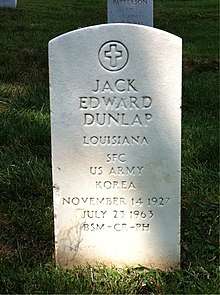Jack Dunlap
Jack Edward Dunlap (November 14, 1927 – July 23, 1963) was a United States Army sergeant stationed at the National Security Agency who later became a spy for the Soviet Union in the early 1960s.
Jack Edward Dunlap | |
|---|---|
 Grave at Arlington National Cemetery | |
| Born | November 14, 1927 Bogalusa, Louisiana, USA |
| Died | July 23, 1963 (aged 35) |
| Nationality | |
NSA spying activities
As an army sergeant assigned to the NSA, he was not subject to a polygraph examination. When he retired from the Army, his Soviet handlers told him to apply for a civilian position, which he did. He was given a polygraph examination by NSA on a Friday and while he passed the examination, the examiner told the FBI there was something that made him uneasy and told Dunlap to come back on Monday. Dunlap committed suicide over the weekend by carbon monoxide poisoning.
The Director of Security for NSA told FBI agents that he and his assistant paid a visit to Dunlap's widow to offer their condolences, and she said, "You probably want his papers", showing them classified material. That was when the NSA realized Dunlap had been a spy. Dunlap was a personable individual and roamed around within NSA. One secretary told the FBI that he stopped at her desk to chat and would see papers in her out box and tell her he was headed in that direction and take the papers. He would stop at a Xerox machine on the way and make a copy for the Soviets.
References
Bibliography
- Bamford, James (1982). The Puzzle Palace. Penguin Books. pp. 196–200.